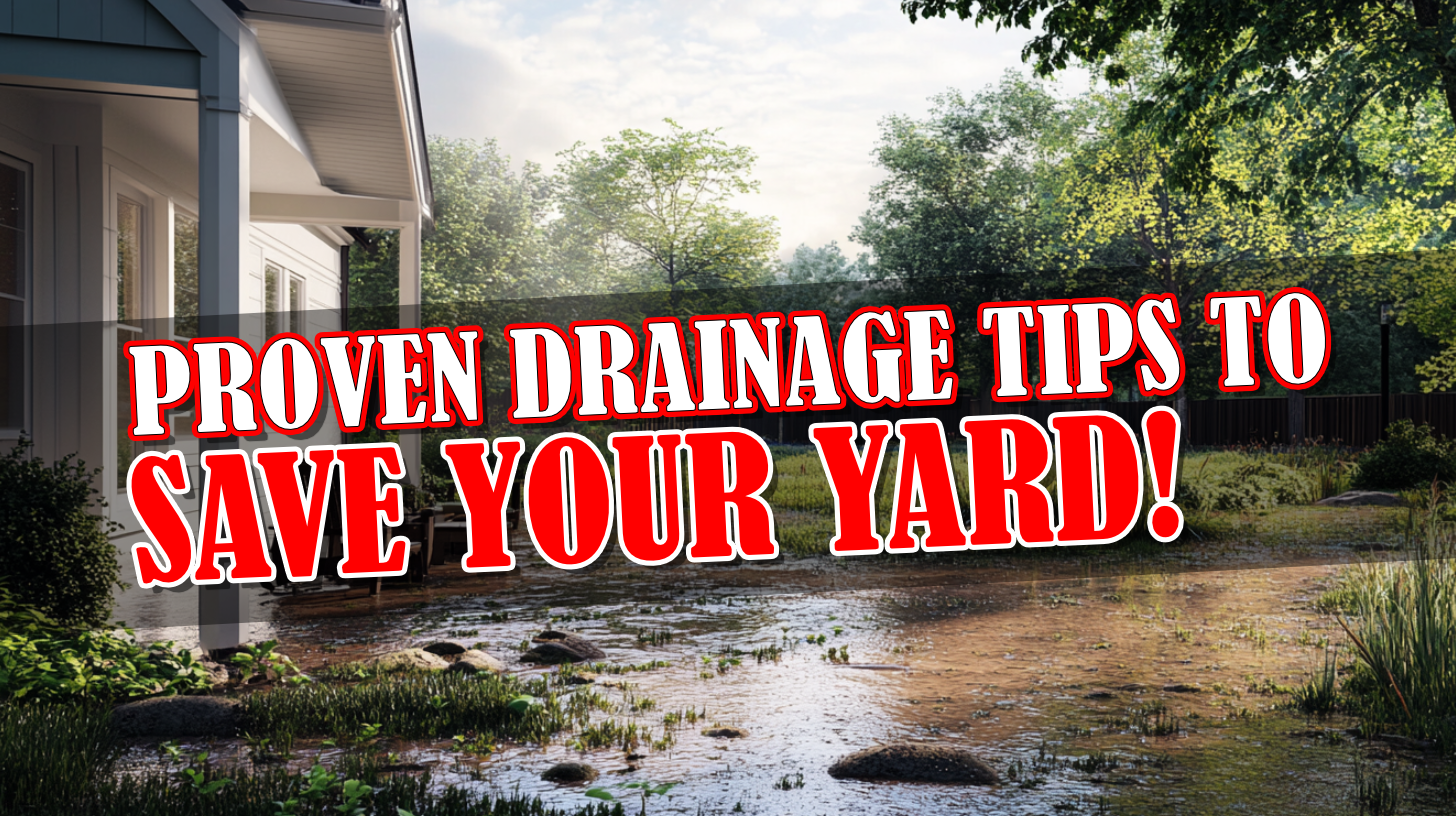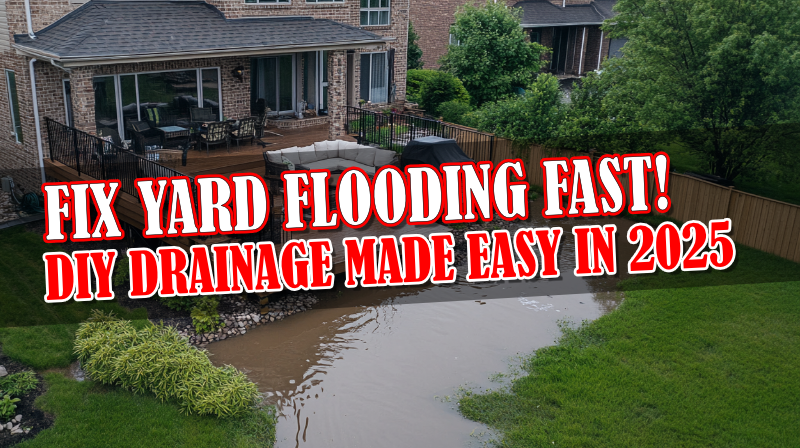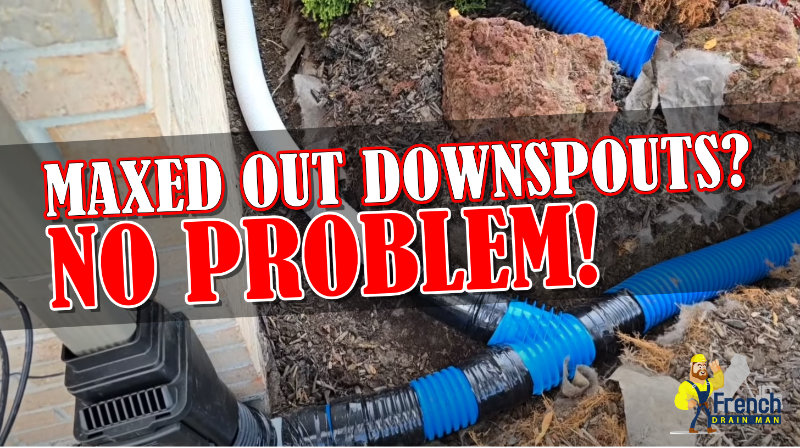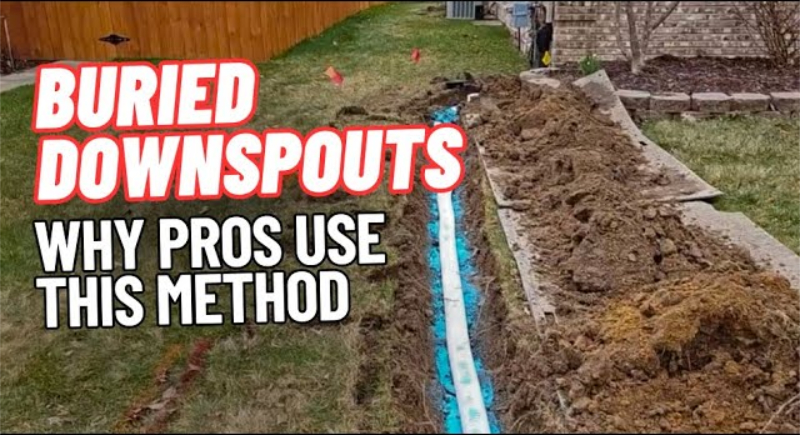Buried Downspouts & Underground Drains for Roof Runoff
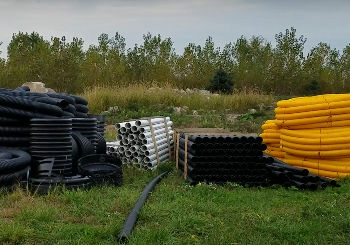 With all the different pipes to choose from, for a homeowner, it can be quite overwhelming. I’m hoping to clarify why we use the pipes we use how we use them and when we use them. There’s three that I use exclusively and then there’s several that I won’t go near and we’ll touch on it all.
With all the different pipes to choose from, for a homeowner, it can be quite overwhelming. I’m hoping to clarify why we use the pipes we use how we use them and when we use them. There’s three that I use exclusively and then there’s several that I won’t go near and we’ll touch on it all.
The number one pipe for me as a single wall corrugated pipe. The reason why this pipe ranks number one with me is that I can run it in one piece. It’s not a pipe that comes in sections. It’s not a pipe that has to be glued together. It’s one from the adapter that goes on the end of the gutter downspout all the way. It doesn’t matter if it’s 30, 40, 50, 60 feet. I don’t care as long as it’s installed correctly. You run into a pop-up and you can run it to a. I liked these six-inch catch basins to, so those are the two that we use.
Why is it so important that it’s one piece to me with all the trees and all the shrubs and residential landscapes, roots, roots are what takes out an underground drainage system. Roots are the Kryptonite to an underground drainage system. So your argument can be, well, we’re going to glue the pipe together. We’re going to glue all these sections together.
Here’s the problem we face in the north, in the Sunbelt region you guys don’t deal with this, but we deal with this. We have to get this pipe down 42 inches or deeper for it not to see the effects of frost and freeze and thaw. That’s impossible in most cases. That’s not realistic.
Running an underground drainage system in your backyard, you’re not going to be beneath the frost, and here in Michigan you’re gonna see that pipe go through all types of stresses. Hydraulics, we can get geeky and go to the math and figure it out, but this pipe is virtually indestructible. It’s very flexible. So as the freeze and thaw cycles occur, it can move as one and come spring, it returns right back to the original slope at which it was installed.
Now, this pipe has been given a bad rap and I want to go over that real quick. The problem is when it’s installed wrong, it will collect the breeze and I’ll explain why. This here has been circulating for a while and it’s the most misunderstood part about the drainage community. It’s as a homeowner, you’re left to think, what do I. What do I believe? Well, I’m just going to give it to you straight. It’s as simple as this. When the water comes out of the trough and it drops into this downspout, that water is accelerating all the way into the point to where it enters the underground drainage system.
At that point, you want to maintain slope on this pipe so that you can keep up your acceleration. You want to keep up your velocity, you’re never going to get it back. If you run this pipe flat, as it loses velocity, you’re not getting it back. It’s lost. So the key is how it’s installed, it has to be installed on a slope. If it’s installed on a slope, it’ll maintain velocity, which flushes out leaves and tree seeds and shingle gravel.
Now how did it get a bad rap? Well, it’s easy to leave a belly in this pipe. Now you’ll hear me say that in videos I have in previous videos and I’m sure I’ll continue to use that term in the future. When you take it under a sidewalk and then you bring it back up and put a pop-up, admit her on it, that’s a belly. Now when the water comes down, it hits a bunch of water that’s just laying in belly. So what ends up happening is you lose all that velocity.
Sure. Eventually, the right of weight does prevail. So water is eight pounds per gallon. So you got two gallons in there. You got 16 pounds worth of water as the gutter downspout loads up during her reign. The right away wins. It’ll push through. You won’t even know there’s a problem, but in the end, you lost all your velocity. That’s what carries out the debris in this pipe, so the installer screws up the pipe get a bad rap. For more than 30 years I’ve been using this pipe and I love it. Now the pipes with the glue joints, the glue welds, they move in the freeze and thaw cycle and it breaks the glue weld. So when you put two pipes together and you have these broken glues welds well tree’s root systems even on shrubs, thats’s the Kryptonite of underground drainage systems. You’re going to plug that system with roots.
Now tree roots are, they start off finer than the human hair. So that’s how they get into the system. And then they grow from there and then they, they break it down, it ends up being a mess. Ends up having to be redone. Again the PVC schedule 40 has a great crush rating. I do use it in industrial jobs where it’s specked in. We’re going to go over that before we end this video, but I just want everyone to understand and be clear that because we can run the single wall corrugated because it comes rolled up, we got these hundred and 50 foot rolls, and we could without any connections, we could run this as far as we need to, as long as we can maintain slope, I’m confident that it’s never going to collect debris and never gonna plug.
Now, what do I do if we end up having to go flat? We just don’t have the slope. I know we’re gonna lose the velocity. I know we’re gonna lose the ability to flush this clean. Well, that’s when I’ll step up to the dual wall and you’ve seen that in previous videos as well. I’ll start featuring it more, but it’s smooth on the inside. It’s dual wall, so you’ve got your corrugated exterior smooth on the inside, so when their velocity goes down, it’ll still carry the debris is very easy. It’s a little more money, but what I like is they’re 20-foot lengths instead of 10-foot lengths and that’s what the PVC pipes are, is 10-foot lengths. Not only is it 20-foot length, so I have fewer connections, but look at the flexibility I got. It’s not. It’s not like the single wall. The single wall is crazy flexible, but it’s pretty good. I can influence this pipe to go up and down hills.
You know when you’re doing walkout basements for example, and you’re running a downspout and you have to go down towards the walkout basement area and take a deep into the back of the yard. This pipe will actually make that without connections. So you do have the 20-foot lengths. So let me get to that. What we do is wherever there’s a tree or shrub or landscape, we have connectors and we actually have a tape, an agricultural tape for this and we’ll wrap it. The tape lasts for a hundred years. This pipe, by the way, and truth, I’ve dug up this pipe and it looks brand new when it’s 40 years old because I’ve dug up some old systems that weren’t run. They didn’t run them correctly, so they had to be redone, but the pipe looks brand new. It’s truly amazing. They’re telling me that this pipe is going to last two to 500 years before it breaks down. I believe it. I believe it. I never see deterioration in his pipe in any way, not from the sun. You know, when it’s exposed and it’s out of the ground and you know, that brings me to a pipe that is constantly being misused and that’s triple wall.
Now what triple wall is, it’s a corrugated pipe and they do this like a laminate, white exterior and then it’s got a black smooth interior. This is ideal for septic fields because they don’t see daylight. It doesn’t have any UV protection, so just look at this. It’s a mess. So don’t use that. It’s tempting because I see, I see people walking out of The Home Depot with it all the time to do their downspouts. Plus I hate these, these adapters that go in the downspout cm squared. You should see during the rain how that’s sprays up. It’s unbelievable. Like a geyser. So you’re losing your velocity to carry the water. Water splashing out. And I’ve seen guys on videos use silicone. Why? Why? Look at how nice these are. It’s ramped. It’s ramped. It doesn’t spray out. You don’t have this huge spray and you don’t need to silicone it. So for me, corrugated pipe is my goto. I’ll always go to the single wall first and then if I find a need for the dual wall because I need a smooth interior, I’m going to lose my velocity. The water is going to slow down on me. I don’t feel like we’re going to carry any debris very well. I’ll run this smooth wall. No. If I get a flat spot in my run, I’ll go to this dual wall and then I’ll it to this little six-inch NDS catch basin so the homeowner can maintain the system by cleaning it out as needed.
Now do stay away from this as a homeowner because I know it’s so tempting. You see this in a store and you’re thinking, oh, this is great. It fits in the back of my car seat and I could just extend it Let’s see here. There you go. Boy, that’s pretty impressive. Pretty neat, and you can pull it to it to the point to where it’s 10 feet long, but that is the end result. It’s garbage. Stay away from it.
I also want to touch base on this. This is the area that my systems, if they’re gonna not work, it’s because they got plugged up in the gutter troughed, so before the water ever made it to the downspout, you end up with a bunch of leaves just plugging this hole so that now the gutter troughed loads up with water and it gets so heavy that it pulls it away from the fascia board. That’s how gutters ended up all screwed up and then you end up with this cascading effect and all the water runs over the gutter and just floods out the landscapes. Now you got water coming in the basement and you’re blaming what the underground drainage systems not working.
In a case like this, what you need is leaf guards. You need to put leaf guards on. None of us need to be going up and down a ladder, cleaning gutters out all the time, so I really recommend you definitely put leaf guards if you have a lot of large trees.
Now they do make for the hard pipe, a more centered adapter, you know opposed to the one that squared and sprays a mist and just makes a mess. But the problem is you end up having to be too far off the wall of the house and then you got to have slope so you tilt your hard pipe. That’s why I like the corrugated pipe. It has all that flexibility that I showed. That looks terrible. It’s off the house. It just looks terrible. Now, where does this PVC Schedule 40 belong? Right here. Commercial building. There is no trees or shrubs. This is running under the parking lot. Even if the pipe moves in winter and it breaks the glue welds, there are no trees around. It’s all asphalt or concrete. Here’s another one. You know did it a clean out. Nice, neat job. I like it. Anyways, go under the asphalt parking lot. There are no trees. There are no shrubs. So that’s where the schedule 40 belongs.
Here in the north you’re not gonna beat a single wall. Corrugated pipe. And again, if you can’t maintain slope, just go to your dual wall and I know I featured the dual wall in other videos, if you haven’t seen them yet, then you know they’re up and coming or watched the playlist until you get to it. That’s kind of the 101 of downspouts.
If you’re looking for an underground drainage system in southeastern Michigan, give us a call at 248-505-3065.
Be sure to visit the French Drain Man YouTube Channel and subscribe.





